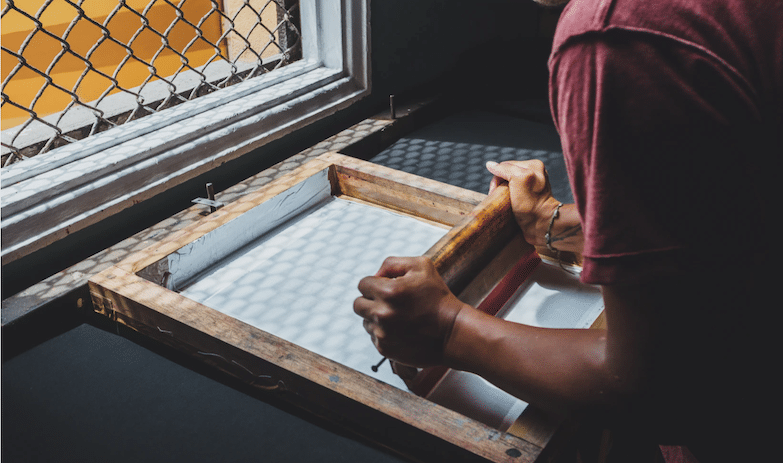The process of screen printing can be as simple or as complex as necessary. In the most complex way, it requires specialist complex equipment in order to produce a one off print; whereas in the most simplest of ways, there is little in the way of outlay required and can be used to produce large batches of identical images. Regardless of the individual scenario, the process of screen printing is clearly a useful one given that it has been used throughout history for hundreds of years.
During more recent times, the process of screen printing has really accelerated and is present on so many of the different products that we purchase in our day to day lives – from things like electronic components, promo pens, tee shirts, and there is even screen printing on glass bottles to promote certain beers etc. As the technology continues to develop, it will be interesting to see how exactly the screen printing process changes to become more advanced and open up new opportunities.
Screen Printing Explained
In the very simplest term, screen printing involves an ink block stencil that is placed on a mesh woven frame and sees ink or any other printable materials pushed through and on to the fabric, paper, or whatever surface that has been chosen to be printed on to. The transferring of the design is achieved via the use of a squee gee or a blade that is moved across the stencil, pushing the paint or the ink through all of the many holes that are in the mesh. It is likely that you have been taught the very basics of this back in high school, but at the hands of an expert, great results are possible.
In the most basic of terms, there is a base with a material laid on top and a template placed above of that, and then a screen. Paint or ink is put onto this and then with a blade pull it across the screen so that all of the color is spread right across it to create the desired design.
First Screen Printing Attempts
Although screen printing may appear to be somewhat of a more modern technique, it has actually been used throughout history for thousands of years. It was in the year 1000 CE when the Chinese first started using the screen printing process.
However, there is actually some evidence to suggest that a similar process was used before this with charcoal and leaves. This was found in caves in France and Spain and are believed to date back all the way to Neolithic times. In addition to this, similar evidence has been found out in the Pacific and is believed to be the inspiration for the now well known Hawaiian shirt. During medieval times the printing process was used to allow for the mass production of playing cards. It was during the 1600s that that screen printing was first used for producing wallpaper.
The Japanese and the Chinese however were using a much more sophisticated process than all of these, which saw silk placed between a couple of waterproof paper pieces that had specific designs and shapes cut into them. This is actually very similar to the modern screen printing process that is used today. This technique was used by the Asian countries well before it was adopted in other parts of the world.
European Use Of Screen Printing
Europens were lagging behind the Asian countries for some time when it came to screen printing. They did not learn to appreciate the full power of the process until halfway through the eighteenth century, with French patterns stenciled directly onto fabrics and even items of clothing, such as shoes. It was with the introduction of a silk mesh that dramatically changed things for those living in Europe.
Even during the nineteenth century, the screen printing process used on the continent was still rather primitive and featured a stretched fabric that went over wooden frames to secure the islands and stencils in place whilst the printing process took place. However, in the twentieth century, things really changed as the process became mechanised and was then used for printing onto flat surfaces, such as fabrics, packaging, and posters. From then on, it was used for the purpose of printing wallpaper in color and as a cheaper alternative to wooden block printing.
Unusually, the concept of silk screen printing was not patented until it was done in the UK (Manchester) by a man called Samuel Simon in the year 1907. This may be one explanation as to why many people think that silk screen printing is a relatively new artform that was started in the twentieth century.
Twentieth Century Screen Printing
As is the case with any technology, nothing stays static and so during the second part of the twentieth century, things started to progress. The industry was revolutionised by three different printing professionals who looked into just how chemicals that are photo reactive work for this type of printing.
These printers were called Owens, Peter, and Beck and were responsible for introducing emulsions of chromic acid salt to the printing process. This resulted in designs being produced that were sensitised by light. However, this was simply the beginning of a thrilling journey that saw these new stencils revolutionize the industry and saw images now being printed onto various different surfaces.
Modern Developments In Screen Printing
Today the mass production of screen prints is done in various colors and can be done onto pretty much any type of surface, including items of clothing, glass, metals, wood, and paper. For this reason, screen printing has been dubbed as ‘the most versatile of all printing processes’. It is easy to see thern why it has and continues to boom in popularity.
More recently the process of screen printing has developed a synonymous status with radicalism and certain subcultures who have really embraced the artform. Couple this with computer led graphic design and the possibilities for screen printing are endless.










